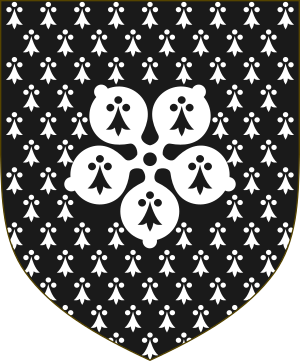William Flower (officer of arms) facts for kids
William Flower (1497/98–1588) was an important English Officer of Arms during the reigns of King Henry VIII, King Edward VI, Queen Mary I, and Queen Elizabeth I. He rose to a high position called Norroy King of Arms. He held this role from 1562 until he passed away in 1588.
Contents
William Flower's Life and Work
William Flower was born in York around 1498. His father, John Flower, was a tailor and merchant. William started his career as a "pursuivant extraordinary" in 1536. A pursuivant was like an assistant to a herald, helping with official messages and ceremonies.
Early Career and Missions
In 1543, while working as a pursuivant, William was sent to Rouen, France. His job was to visit English merchants and sailors who had been captured by the French. He was later promoted to Rouge Croix Pursuivant in 1544 and then to Chester Herald of Arms in 1546. A herald was an officer who managed coats of arms, royal ceremonies, and official messages.
In 1551, William Flower traveled to Paris with Gilbert Dethick, who was the Garter Principal King of Arms. They went with William Parr, 1st Marquess of Northampton to give the Order of the Garter award to Henry II of France. For this trip, William received ten shillings a day for his "dyett," which meant his food and lodging.
Important Messages and Promotions
In 1555, William Flower was given permission to act as a deputy for Thomas Hawley, the Clarenceux King of Arms. This meant he could help with official duties in London.
In 1560, William Flower delivered a message from the Duke of Norfolk to Mary of Guise in Edinburgh, Scotland. At first, they spoke in the "Scottish tongue," but William couldn't understand it well. So, they continued their conversation in French.
William Flower was promoted to Norroy King of Arms on February 8, 1562. This was a very important role, as a King of Arms was the chief officer in charge of heraldry for a specific region.
Family and Later Life
William Flower married Helen Davyes. They had five children: two sons named Gilbert and Edward, and three daughters named Elizabeth, Jane, and Eleanor. His daughter Elizabeth married Robert Glover, who was also an officer of arms (Somerset Herald).
As William got older, he started working with his son-in-law, Robert Glover, in his role as Norroy King of Arms. This happened in 1580, when William was about 82 years old.
William Flower passed away in Windsor in the autumn of 1588. His will, which is a document stating his wishes for his property, was officially approved in London in November of that year.
What Were Heraldic Visitations?
In 1530, King Henry VIII created rules for something called "heraldic visitations." During these visits, the Kings of Arms (like William Flower) or their helpers would travel around their areas. Their job was to record coats of arms and family trees of people who had the right to use them. They could even stop people from using coats of arms if they weren't allowed to.
William Flower started his visitations in 1563–64. His last visitation was in 1575. His son-in-law, Robert Glover, often helped him. Records from Flower's visits to places like Yorkshire, Lancashire, Nottingham, and Durham are still kept at the College of Arms in London.
In 1578, William Flower made an official announcement. He stated that only his deputy, Peter Proby, could give permission for heraldic painting. This included painting coats of arms on things like funeral banners and shields. This rule helped make sure that only approved artists created these important symbols.
William Flower's Coat of Arms
 |
|
Learn More

